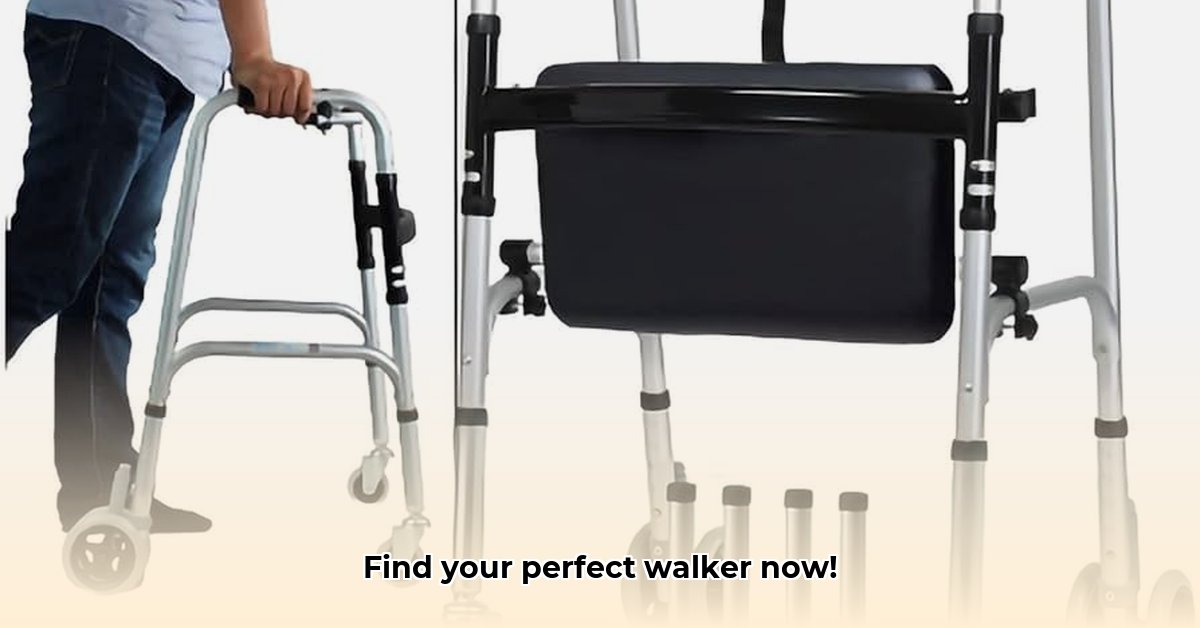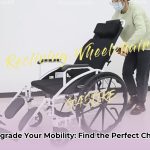As we age or face health challenges, getting around can become more difficult. The right walking aid can significantly improve safety and independence. This comprehensive guide aims to help you navigate the world of walkers and rollators, ensuring you find the perfect fit. We’ll explore various types, selection criteria, maintenance tips, and essential safety precautions. We’ll also offer advice on what to consider when purchasing, enabling you to make an informed decision that aligns with your needs and budget. Whether you’re recovering from an injury or simply seeking extra support, this resource will empower you to discover the mobility aid that allows you to live life to the fullest.
Handicap Walkers: Finding Your Perfect Walking Partner
Choosing the right mobility aid can seem overwhelming, but finding the perfect handicap walker or rollator is achievable! This comprehensive guide will lead you through the process, assisting you in selecting the ideal fit for your unique needs and lifestyle. We’ll delve into different types, essential features, and key considerations to enhance your mobility and overall well-being.
Understanding Your Needs: Stability vs. Mobility
The first step is identifying your primary need: stability or mobility. Do you require robust support for short, frequent trips within your home, or a more maneuverable device for longer walks outdoors? Your answer will determine the most suitable type of walker.
-
Standard Walkers: These are the dependable workhorses of the walker family. With four legs providing unwavering support, they’re perfect for short distances and individuals recovering from injuries or surgeries. Requiring you to lift them with each step, they excel in providing maximum stability over shorter distances. Consider them your steadfast companion, offering reliable support for quick trips around the house.
-
Rolling Walkers: Equipped with two to four wheels, typically on the front legs, rolling walkers offer a balance between stability and mobility. Easier to push than standard walkers, they provide smoother movement while maintaining a degree of support. Ideal for those who need assistance moving around without the full commitment of a rollator, they enhance maneuverability while ensuring stability.
-
Rollators: Rollators represent the most mobile option, featuring wheels on all legs, brakes for controlled stopping, and often a built-in seat for convenient rests. They’re perfect for longer walks, shopping trips, and outdoor excursions. If independence and the ability to travel farther are your priorities, then a rollator is likely the best choice. Envision it as your comfortable, personal vehicle, empowering you to embark on walking adventures with confidence and promoting independence.
Choosing Your Perfect Handicap Walker: A Step-by-Step Guide
Selecting the right walker involves several key considerations to ensure mobility, safety, and comfort:
Step 1: Assess Your Mobility Needs. How far do you typically walk daily? How comfortable are you moving around independently? Are there specific challenges you encounter, such as uneven terrain or crowded spaces? Consulting a physical or occupational therapist can provide personalized recommendations to address your unique mobility restrictions.
Step 2: Establish a Budget. Walker and rollator prices can vary widely, ranging from approximately $60 to over $500, depending on features, materials, and brand. Establishing a budget beforehand will streamline your search and help you focus on options that align with your financial capabilities.
Step 3: Consider Physical Limitations. Do you have arthritis or other conditions that affect your grip strength or dexterity? Look for walkers with ergonomic handles and easy-to-use brakes. Are there any other physical limitations that might influence your choice, such as limited range of motion or balance issues?
Step 4: Verify Weight Capacity. Ensure the walker’s weight capacity exceeds your weight by a comfortable margin—most quality models support at least 300 pounds or more. This ensures safety, stability, and the longevity of the device.
Step 5: Evaluate Desired Features. Do you require brakes for controlled stopping? Would a seat be beneficial for taking rests during longer walks? Do you want a basket or pouch for carrying personal items? Consider which features would simplify your daily life and enhance your overall comfort and convenience.
Handicap Walker Buying Guide: What to Look For
Prior to making a purchase, consider these essential points to ensure optimal comfort, safety, and performance:
-
Materials: Aluminum is lightweight, durable, and rust-resistant, while steel is heavier but exceptionally sturdy. The material significantly affects the walker’s overall weight, durability, and ease of use.
-
Warranty: A comprehensive warranty demonstrates the manufacturer’s confidence in their product’s quality and reliability. Look for a warranty that covers defects in materials and workmanship for at least one year.
-
Adjustability: Adjustable height is paramount for maintaining proper posture, comfort, and safety. Ensure the walker can be adjusted to your specific height, allowing you to stand upright with your shoulders relaxed and your elbows slightly bent.
-
Handle Features: Comfortable handles are crucial for reducing strain and fatigue during use. Look for handles that are ergonomically designed, with a non-slip surface and a comfortable grip.
-
Brakes (for Rollators): If you’re considering a rollator, verify that the brakes are easy to engage, reliable, and responsive. Test the brakes on different surfaces to ensure they provide adequate stopping power.
Maintaining Your Handicap Walker: Simple Care Tips
Regular maintenance will keep your walker in optimal condition, ensuring long-term reliability and safety:
-
Regular Cleaning: Wipe down the frame, handles, and wheels regularly with a damp cloth and mild detergent. This will remove dirt, debris, and grime, keeping your walker clean and hygienic.
-
Wheel and Brake Checks: Periodically inspect the wheels for wear and tear, ensuring they rotate freely and smoothly. Check the brakes regularly, making sure they engage properly and provide adequate stopping power.
-
Tightness Check: Ensure all bolts, screws, and fasteners are securely tightened. Loose parts can compromise the walker’s stability and safety.
Safety First: Important Tips for Using Your Walker
Safety should always be your top priority when using a walker or rollator. Follow these essential tips to prevent falls and injuries:
-
Maintain Good Posture: Stand tall with your shoulders relaxed and your head up. Avoid slouching or leaning forward, which can strain your back and neck.
-
Be Aware of Your Surroundings: Pay attention to uneven surfaces, obstacles, and potential hazards in your path. Avoid using your walker on slippery or unstable surfaces.
-
Use a Consistent Gait: Maintain a steady, controlled walking pace. Avoid rushing or taking excessively large steps, which can compromise your balance.
-
Engage Brakes When Stopping: When coming to a stop, always engage the brakes on your rollator to prevent it from rolling away.
Comparing Popular Handicap Walker Models
Please note that the features and prices of specific models can change over time. The following provides a snapshot of typical options available as of 2024:
| Model Name | Price Range (USD) | Weight Capacity (lbs) | Pros | Cons |
|---|---|---|---|---|
| Drive Medical Two Button Walker | $60-$150 | 300 | Lightweight, easy to fold for storage and transport, affordable, provides good stability. | Limited features, basic design, may not be suitable for individuals requiring more advanced support. |
| Nova GetGo Classic Rollator | $100-$250 | 300-400 (varies by model) | Durable construction, adjustable height, comfortable seat (on some models), provides good maneuverability. | May be heavier than some other models, some models may lack certain features (e.g., basket, cup holder). |
| Hugo Mobility Explore Rollator | $200-$400 | 300 | Ergonomic handles, comfortable padded seat, adjustable height, includes a basket for carrying items, stylish design. | More expensive than basic models, may be too bulky for use in tight spaces. |
| Lumex Walkabout Lite Rollator | $150-$300 | 300 | Lightweight aluminum frame, compact folding design, comfortable handles, adjustable height. | Smaller wheels may not be suitable for rough terrain, limited weight capacity compared to some models. |
Important Reminder: Consulting with an occupational therapist or other qualified healthcare professional can provide personalized recommendations and ensure you choose the best walker or rollator for your specific needs and circumstances. Selecting the right mobility aid is an investment in your independence, safety, and well-being.
How to Choose Between a Walker and Rollator for Elderly Parents with Limited Mobility
Key Considerations:
- Walkers provide greater stability, making them ideal for individuals with significant balance issues or weakness.
- Rollators offer enhanced mobility and convenience, suitable for stronger individuals who require support for longer distances.
- Carefully assess your parent’s physical abilities, living environment, and daily activities when making a decision.
- Proper height adjustment is crucial for comfort, safety, and preventing strain or injury.
- Always verify the weight capacity of the device and consider bariatric models if necessary.
Understanding the Differences: Walkers vs. Rollators
Choosing between a walker and a rollator for your aging parent can seem daunting, but understanding the key differences between these mobility aids will simplify the decision-making process. Both
- Corporate Wellness Programs Cost Factors Impacting Your Company Budget - December 18, 2025
- Unpacking the Cost of Wellness Programs and Their Real Value - December 17, 2025
- How Much Do Wellness Programs Cost Businesses To Offer? - December 16, 2025
















